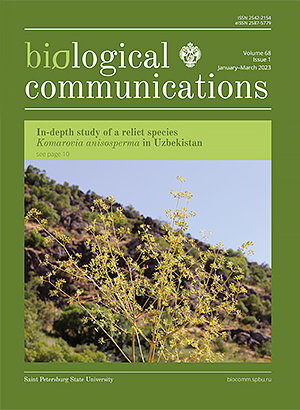New data on the morphological and anatomical structure, chemical composition and distribution area of a rare species Komarovia anisosperma in Uzbekistan
DOI:
https://doi.org/10.21638/spbu03.2023.102Abstract
For the first time, the morphological and anatomical structure of vegetative and generative organs, the localization of secretory ducts in the underground and aboveground parts of the species plants were studied. New GIS technologies were used to elucidate the spatial structure of the rare endemic species Komarovia anisosperma of the monotypic genus Komarovia Korovin of the Apiaceae family. The performed analysis showed the most significant diagnostic features of the studied organs, such as a deep taproot system, the presence of a multi-branched caudex, underdeveloped stem leaves or stem leaves reduced to sheaths, the central cylinder of the main root showing separate concentric circles of large and small vascular bundles, the presence of numerous secretory ducts in the secondary root cortex, strongly elongated palisade leaf cells etc. As a result of phytochemical study, extracts of Komarovia anisosperma roots and inflorescences were analyzed. According to our data, the main component of underground organs from terpenes was α-muurolene, and for inflorescences it was α-curcumene. Grid mapping showed that the species is mainly concentrated in the Samarkand and Kashkadarya regions, where the most favorable conditions for its growth are found. These areas are the natural area of origin of the species, and the establishment of a protected natural area has led to an increase in the number of natural populations.
Keywords:
anatomy, coumarins, gas-chromatography, GIS technology, grid mapping, Komarovia anisosperma, leaf, root, secretory ducts, terpenes
Downloads
References
Downloads
Published
How to Cite
License
Articles of Biological Communications are open access distributed under the terms of the License Agreement with Saint Petersburg State University, which permits to the authors unrestricted distribution and self-archiving free of charge.





